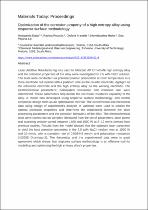 ResearchSpace
ResearchSpace
Optimization of the corrosion property of a high entropy alloy using response surface methodology
JavaScript is disabled for your browser. Some features of this site may not work without it.
- ResearchSpace
- →
- Research Publications/Outputs
- →
- Journal Articles
- →
- View Item
| dc.contributor.author |
Dada, M

|
|
| dc.contributor.author |
Popoola, P

|
|
| dc.contributor.author |
Aramide, O

|
|
| dc.contributor.author |
Mathe, Ntombizodwa R

|
|
| dc.contributor.author |
Pityana, Sisa L

|
|
| dc.date.accessioned | 2020-10-12T07:32:48Z | |
| dc.date.available | 2020-10-12T07:32:48Z | |
| dc.date.issued | 2020-06 | |
| dc.identifier.citation | Dada, M., Popoola, P., Aramide, O., et al. 2020. Optimization of the corrosion property of a high entropy alloy using response surface methodology. Materials Today: Proceedings, pp. 1-7 | en_US |
| dc.identifier.issn | 2214-7853 | |
| dc.identifier.uri | https://doi.org/10.1016/j.matpr.2020.05.618 | |
| dc.identifier.uri | https://www.sciencedirect.com/science/article/pii/S2214785320342218 | |
| dc.identifier.uri | http://hdl.handle.net/10204/11626 | |
| dc.description | Copyright: 2020, Elsevier. Due to copyright restrictions, the attached PDF file contains the abstract of the full-text item. For access to the full-text item, please consult the publisher's website. | en_US |
| dc.description.abstract | Laser Additive Manufacturing was used to fabricate AlTiCrFeCoNi high entropy alloy and the corrosion properties of the alloy were investigated in 3.5 wt% NaCl solution. The tests were conducted via potentiodynamic polarization at room temperature in a three-electrode cell system with a platinum wire as the counter electrode, Ag/AgCl as the reference electrode and the high entropy alloy as the working electrode. The electrochemical parameters; polarization resistance and corrosion rate were determined. These parameters help decide the corrosion resistance capability of the alloy. A model was developed using response surface methodology, and central composite design tools as an optimization method. The experimental and theoretical data using design of experiment’s analysis of variance were used to predict the optimal corrosion properties and determine the relationship between the laser processing parameters and the corrosion behaviour of the alloy. The electrochemical tests were carried out on samples fabricated from the set of parameters; laser power and scanning velocity varied between 1400 and 1600 W at 8–12 mm/s derived from previous studies. Results from the model showed that the optimum laser parameter to yield the best corrosion properties in the 3.5 wt% NaCl medium was at 1500 W and 10 mm/s, with a corrosion rate of 0.003445 mm/yr and polarization resistance 0.00255 O.cm(sup-2). The theoretical and the experimental data were in good agreement which shows that response surface methodology is an effective tool for modelling and optimizing the high entropy alloy’s properties. | en_US |
| dc.language.iso | en | en_US |
| dc.publisher | Elsevier | en_US |
| dc.relation.ispartofseries | Workflow;23789 | |
| dc.subject | Corrosion | en_US |
| dc.subject | High entropy alloys | en_US |
| dc.subject | Laser additive manufacturing | en_US |
| dc.subject | Predictive modelling | en_US |
| dc.subject | Sodium Chloride | en_US |
| dc.title | Optimization of the corrosion property of a high entropy alloy using response surface methodology | en_US |
| dc.type | Article | en_US |
| dc.identifier.apacitation | Dada, M., Popoola, P., Aramide, O., Mathe, N. R., & Pityana, S. L. (2020). Optimization of the corrosion property of a high entropy alloy using response surface methodology. http://hdl.handle.net/10204/11626 | en_ZA |
| dc.identifier.chicagocitation | Dada, M, P Popoola, O Aramide, Ntombizodwa R Mathe, and Sisa L Pityana "Optimization of the corrosion property of a high entropy alloy using response surface methodology." (2020) http://hdl.handle.net/10204/11626 | en_ZA |
| dc.identifier.vancouvercitation | Dada M, Popoola P, Aramide O, Mathe NR, Pityana SL. Optimization of the corrosion property of a high entropy alloy using response surface methodology. 2020; http://hdl.handle.net/10204/11626. | en_ZA |
| dc.identifier.ris | TY - Article AU - Dada, M AU - Popoola, P AU - Aramide, O AU - Mathe, Ntombizodwa R AU - Pityana, Sisa L AB - Laser Additive Manufacturing was used to fabricate AlTiCrFeCoNi high entropy alloy and the corrosion properties of the alloy were investigated in 3.5 wt% NaCl solution. The tests were conducted via potentiodynamic polarization at room temperature in a three-electrode cell system with a platinum wire as the counter electrode, Ag/AgCl as the reference electrode and the high entropy alloy as the working electrode. The electrochemical parameters; polarization resistance and corrosion rate were determined. These parameters help decide the corrosion resistance capability of the alloy. A model was developed using response surface methodology, and central composite design tools as an optimization method. The experimental and theoretical data using design of experiment’s analysis of variance were used to predict the optimal corrosion properties and determine the relationship between the laser processing parameters and the corrosion behaviour of the alloy. The electrochemical tests were carried out on samples fabricated from the set of parameters; laser power and scanning velocity varied between 1400 and 1600 W at 8–12 mm/s derived from previous studies. Results from the model showed that the optimum laser parameter to yield the best corrosion properties in the 3.5 wt% NaCl medium was at 1500 W and 10 mm/s, with a corrosion rate of 0.003445 mm/yr and polarization resistance 0.00255 O.cm(sup-2). The theoretical and the experimental data were in good agreement which shows that response surface methodology is an effective tool for modelling and optimizing the high entropy alloy’s properties. DA - 2020-06 DB - ResearchSpace DP - CSIR KW - Corrosion KW - High entropy alloys KW - Laser additive manufacturing KW - Predictive modelling KW - Sodium Chloride LK - https://researchspace.csir.co.za PY - 2020 SM - 2214-7853 T1 - Optimization of the corrosion property of a high entropy alloy using response surface methodology TI - Optimization of the corrosion property of a high entropy alloy using response surface methodology UR - http://hdl.handle.net/10204/11626 ER - | en_ZA |





